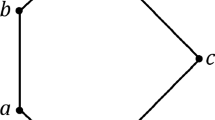Abstract
In order to represent lattice pseudoeffect algebras, a non-commutative generalization of lattice effect algebras, in terms of a particular subclass of near semirings, we introduce in this article the notion of near pseudoeffect semiring. Taking advantage of this characterization, in the second part of the present work, we present, as an application, an alternative, rather straight as well as simple, explanation of the relationship between lattice pseudoeffect algebras and pseudo-MV algebras by means of a simplified axiomatization of generalized Łukasiewicz semirings, a variety of non-commutative semirings equipped with two antitone unary operations.
Similar content being viewed by others
Explore related subjects
Discover the latest articles, news and stories from top researchers in related subjects.References
Belluce LP, Di Nola A, Ferraioli AR (2013) MV-semirings and their sheaf representations. Order 30(1):165–179
Beran L (2011) Orthomodular lattices: an algebraic approach. Mathematics and its applications. Springer, Netherlands
Bonzio S, Chajda I, Ledda A (2016) Representing quantum structures as near semirings. Logic J IGPL 24(5):719–742
Chajda I (2012) Basic algebras and their applications. An overview. In: Czermak J et al (eds) Proceedings of 81st workshop on general algebra, Salzburg, Austria, 2011. Johannes Heyn, Klagenfurt, pp 1–10
Chajda I, Länger H (2015) Commutative basic algebras and coupled near semirings. Soft Comput 19:1129–1134
Chajda I, Länger H (2017) A representation of lattice effect algebras by means of right near semirings with involution. Int J Theor Phys 56:3719–3726
Dalla Chiara ML, Giuntini R, Greechie R (2004) Reasoning in quantum theory: sharp and unsharp quantum logic. Kluwer, Dordrecht
Dvurečenskij A (2001) Pseudo MV algebras are intervals in \(\ell \)-groups. J Aust Math Soc 72:427–445
Dvurečenskij A (2015) Lexicographic pseudo MV-algebras. J Appl Logic 13:825–841
Dvurečenskij A, Pulmannová S (2000) New trends in quantum structures. Mathematics and its applications. Kluwer, Dordrecht
Dvurečenskij A, Vetterlein T (2001a) Pseudoeffect algebras I, basic properties. Int J Theor Phys 40:685–701
Dvurečenskij A, Vetterlein T (2001b) Pseudoeffect algebras II, group representations. Int J Theor Phys 40:703–726
Dvurečenskij A, Vetterlein T (2004) Non-commutative algebras and quantum structures. Int J Theor Phys 43(7/8):15–63
Foulis DJ, Bennett MK (1994) Effect algebras and unsharp quantum logics. Found Phys 24:719–742
Foulis DJ, Pulmannová S, Vincenková E (2011) Lattice pseudoeffect algebras as double residuated structures. Soft Comput 12:2479–2488
Georgescu G, Iorgulescu A (2001) Pseudo MV-algebras. Mult Valued Logic 6:95–135
Giuntini R, Greuling H (1989) Toward a formal language for unsharp properties. Found Phys 19:931–945
Głazek K (2002) A guide to the literature on semirings and their applications in mathematics and information sciences. Springer, Berlin
Kadji A, Lele C, Nganou JB (2016) A non-commutative generalization of Łukasiewicz rings. J Appl Logic 16:1–13
Kalmbach G (1983) Orthomodular lattices, volume 18 of London mathematical society monographs. Academic Press, London
Mundici D (1986) Interpretation of AFC\(^*\)-algebras in Łukasiewicz sentential calculus. J Funct Anal 65:15–63
Rachůnek J (2001) A non-commutative generalization of MV-algebras. Czechoslov Math J 52:255–273
Vitolo P (2010) Compatibility and central elements in pseudo-effect algebras. Kybernetica 46(6):996–1008
Acknowledgements
The research of I. Chajda is supported by IGA, Project PřF 2018 012. D. Fazio and A. Ledda gratefully acknowledge the support of the Horizon 2020 program of the European Commission: SYSMICS Project, Number: 689176, MSCA-RISE-2015. A. Ledda expresses his gratitude for the support of Fondazione di Sardegna within the project “Science and its Logics: The Representation’s Dilemma”, Cagliari, Number: F72F16003220002, and for the support of Regione Autonoma della Sardegna within the project “Order-theoretical properties in mathematics and in physics”, CUP: F72F16002920002.
Author information
Authors and Affiliations
Corresponding author
Ethics declarations
Conflict of interest
The authors declared that they have no conflict of interest.
Ethical approval
This article does not contain any studies with human participants performed by any of the authors.
Additional information
Communicated by A. Di Nola.
Rights and permissions
About this article
Cite this article
Chajda, I., Fazio, D. & Ledda, A. A semiring-like representation of lattice pseudoeffect algebras. Soft Comput 23, 1465–1475 (2019). https://doi.org/10.1007/s00500-018-3157-2
Published:
Issue Date:
DOI: https://doi.org/10.1007/s00500-018-3157-2



